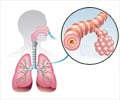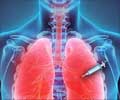Symptoms and Signs of Pneumoconiosis
A person with pneumoconiosis initially may not show any symptoms. Subsequently, he/she develop symptoms due to due to deceased oxygen circulating in the blood, respiratory and heart failure. The symptoms include -
- Cough,
- Shortness of breath,
- Chest pain,
- Difficulty breathing,
- Wheezing,
- Bluish coloration of the skin
- Swelling of feet
- Liver enlargement due to heart failure.
The disease course in common pneumoconioses is described below -
Silicosis
Silicosis may be acute, accelerated, chronic or conglomerate.
- Acute silicosis
It occurs in individuals exposed to freshly fractured silica dust. The lungs show accumulation of protein fluid. Patients have difficulty in breathing, cough, weight loss, fatigue. They may become blue and develop respiratory failure.
- Accelerated silicosis
It occurs within 10 years of heavy exposure to silica dust. The lungs show presence of protein fluids as well as thickened inflamed areas called granulomas with fibrosis. These patients are more likely to develop severe lung disease called pulmonary massive fibrosis. Both acute and accelerated silicosis can lead to death.
- Chronic silicosis
It occurs due to exposure to silica dust over a long period usually more than 10 years. It causes fibrous nodules in the lungs that may get calcified. Chronic bronchitis, heart failure and respiratory failure may occur.
- Conglomerate silicosis
In conglomerate silicosis, the nodules increase in size and number and join together to affect large areas of the lung. It results in pulmonary massive fibrosis.
Coal worker’s pneumoconiosis
Coal worker’s pneumoconiosis, also known as black lung occurs after 15 to 20 years of exposure to coal dust. It may be simple or complicated.
- Simple coal worker’s pneumoconiosis
It occurs due to accumulation of coal particles in the lungs. Patients with this condition often do not have any symptoms though lung function tests may be abnormal.
- Complicated coal worker’s pneumoconiosis
After prolonged periods of exposure, patients develop chronic bronchitis, emphysema and COPD. The lungs develop fibrous nodules. These nodules may join together in later stages to form large areas of fibrosis called pulmonary massive fibrosis. This may be followed by formation of cavities within the lungs. When pulmonary massive fibrosis occurs along with rheumatoid arthritis, the condition is called Caplan’s syndrome after the physician who first described the condition.
- Asbestosis
In asbestosis, the patient develops thickenings of the lungs or the covering of the lungs called the pleura. The lung may develop pulmonary massive fibrosis in the later stages. Asbestosis causes symptoms like cough, chest pain, clubbing of fingers and decrease in lung function tests. The physician may hear some sounds called rales from the lungs using a stethoscope.















